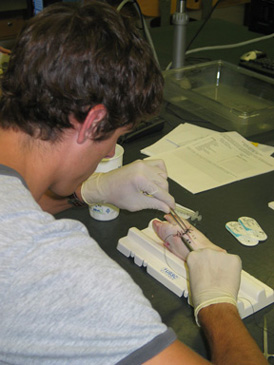 |
Medical student James Clements of Fremont practices suturing on a pig’s foot. |
Nearby, her classmates read electrocardiograms, sutured pig’s feet, inserted flexible nasogastric tubes in each other, and started intravenous lines.
Each summer, rising third-year students in the UNMC College of Medicine spend three days learning such basic clinical skills during an intense, hands-on instructional course known as “June Term.” All UNMC students are required to attend and participate in the course.
The introductory sessions are helpful as students begin their clinical rotations in early July, said Kurtis Cornish, Ph.D., who has coordinated June Term since 1998.
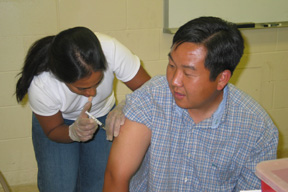 |
Heather Gomes of Grand Island gives an injection to Ty Higuchi of Fort Collins, Colo. |
Alison Benson of Wakefield, Neb., inserted her first NG tube on classmate Jody Olson of Springer, N.M. “Until now, most of us have had zero opportunity to do this, so it’s helpful to practice on each other,” said Benson, who begins a clinical rotation in York on July 6.
“It also teaches a little bit of empathy,” said Olson, a former flight paramedic.
The approximately 120 medical students were divided into 10 groups and exposed to a variety of topics including urinary catheters, aseptic techniques, basic suturing, tracheal suctioning, infection control, professional conduct and infomatics. Faculty members, volunteer nurses and fourth-year medical students assisted with the instruction.
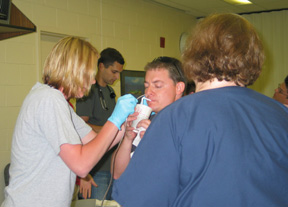 |
Medical student Alison Benson of Wakefield, Neb., inserts a nasogastric tube into classmate Jody Olson of Springer, N.M. |
In addition, students learn the medical vocabulary, tools, protocols and techniques necessary to ensure a smooth transition into the clinical environment.
“Hopefully, we gain confidence,” said James Clements of Fremont, as he first sutured a pig’s foot, then, using a simulated arm, tested arterial blood gases.
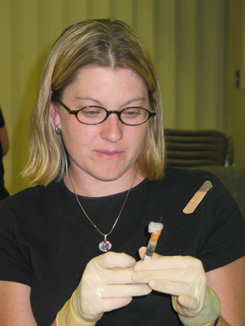 |
Medical student Angie Kratochvil of Kearney prepares to give an injection. |
It also helps student meet a procedural skills requirement for graduation, which was approved in March 1995, Dr. Moore said. Under the policy, students are required to learn a specified procedure, and then demonstrate their ability to properly do it a set number of times before graduating.
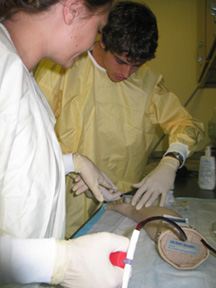 |
Medical student Shannon Kinnan of Gretna observes as James Clements does an arterial blood draw on a simulated arm. |